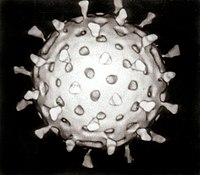
Photo from wikipedia
Abstract Aim Superficial pin site infection is a common problem associated with external fixation, which has been extensively reported. However, the incidence and risk factors with regard to deep infection… Click to show full abstract
Abstract Aim Superficial pin site infection is a common problem associated with external fixation, which has been extensively reported. However, the incidence and risk factors with regard to deep infection are rarely reported in the literature. In this study, we investigate and explore the incidence and risk factors of deep infection following circular frame surgery. For the purpose of this study, deep infection was defined as persistent discharge or collection for which surgical intervention was recommended. Materials and methods This study is retrospective review of all patients who underwent frame surgery between April 1, 2015 and April 1, 2019 in our unit with a minimum of 1 year follow-up following frame removal. We recorded patient demographics, patient risk factors, trauma or elective procedure, number of days the frame was in situ, location of infection and fracture pattern. Results Three-hundred and four patients were identified. Twenty-seven patients were excluded as they were lost to follow-up or had their primary frame surgery as a treatment for infection. This provided us with 277 patients for analysis. The mean age was 47 years (range: 9–89 years), the male to female ratio was 1.5:1, and 80% were trauma frames. Thirteen patients (4.69%) developed deep infection, and all occurred in trauma patients. Of the 13 patients who developed deep infection, 4 had infection before frame removal, and infection occurred in 9 after frame removal. Deep infections occurred in 8 patients within a year of frame removal and in one patient between 1 and 2 years of frame removal. Within the 13 frame procedures for trauma, 12 were periarticular multi-fragmentary fractures, 3 of which were open, and the remaining were an open diaphyseal fracture. The periarticular fractures were more likely to develop deep infection than diaphyseal fractures (p = 0.033). Twelve patients (out of 13) also had concurrent minimally invasive internal fixation with screws in very close proximity of the wires Conclusion The rate of deep infection following circular frame surgery appears to be low. Pooled, multi-centre data would be required to analyse risk factors; however, multi-fragmentary, periarticular fracture and the requirement for additional internal fixation appear to be an associated factor. How to cite this article Ting J, Moulder E, Muir R, et al. The Incidence of Deep Infection Following Lower Leg Circular Frame Fixation with Minimum of 1-year Follow-up from Frame Removal. Strategies Trauma Limb Reconstr 2022;17(2):88–91.
Journal Title: Strategies in Trauma and Limb Reconstruction
Year Published: 2022
Link to full text (if available)
Share on Social Media: Sign Up to like & get
recommendations!